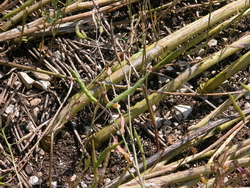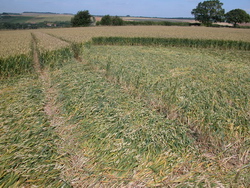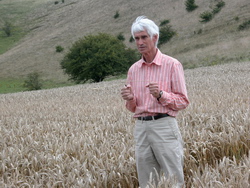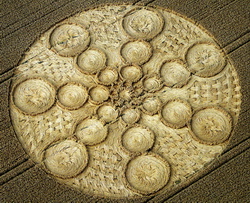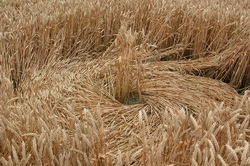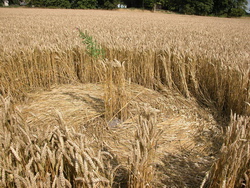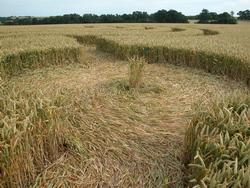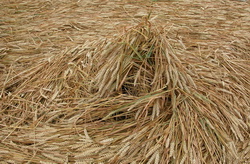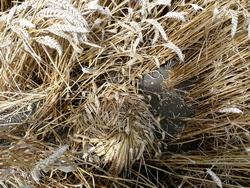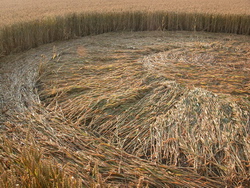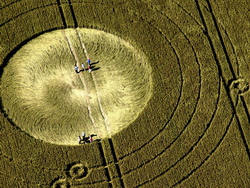
CROP CIRCLES
Real crop circles cannot human-made
Scientific analyses
Biological modifications of the formation crops – compared to control-samples from outside of the formation – have been hilighted by multiple scientific analyses:
- node lenghthening,
- lesser water content in nodes,
- pierced or exploded nodes,
- germination is singnificantly improved (seeds sown produce stronger plants which in turn produce more seeds) once the glyph is formed when the crop matures,
- however, with other samples, germination is weakened (and always significantly so, compared to control-samples) when the glyph is formed in a young crop.
Other thorough analyses conducted by scientists have brought out unexpected modifications of physical and chemical properties of the soil inside formations:
- curiously, a crystal structure has developed in certain components of clay taken from the formation's soil. This oddity is not found in control samples taken outside the formation,
- strange white powder layers formed at the center of certain circular formations in the Netherlands; this powder was analyzed by a University laboratory in Amsterdam and was found to be magnesium hydrocarbonate,
- • an anamalous concentration of meteoritical dust (iron oxides). These particles do exist naturally in the atmosphere but only in very low concentrations. Inside of certain crop circles, contents were found in concentrations several hundred times higher than outside of the formations, suggesting that these particles were attracted to and concentrated by some very strong magnetic field at the time the formations were created.
The first reliable scientific research on this matter was conducted by a team of 3 researchers on W. Levengood's initiative (BLT team) as early as 1989. These American researchers took samples from crop circles in different countries for analysis. They then published the results in specialized scientific journals (3-4-5). The results concerning the growth anomalies were later confirmed by other researchers (6).
Although these scientific analyses did not help elucidate the mystery of the phenomenon, they definitely lead to significant conclusions that highlight the “strange” characteristics thereof. Obviously, these alterations observed on physical and biological properties, undeniably express that the techniques used to create crop circles have nothing to do with the rough and basic techniques usually applied by forgers. Indeed, the only technique used by hoaxers is by flattening the stems to the ground in front of them with just a wooden board with ropes attached to each end, or with a roller which they push or pull. This basic technique cannot in anyway cause physical and biological modifications to plants.
But of course these scientific analyses are heavy to implement and thus cannot be used for every single crop circle.
However, any observer can without fail differentiate genuine crop circles from hoaxes by a few visual observations of the soil.
Bent stalks
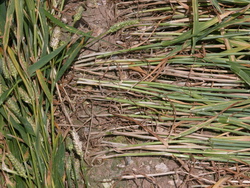
Wheat (or barley) stems consist of several segments linked with three nodes at different heights with the first node being close to the ground. These nodes make the stem more rigid and make it grow vertically.
In most crop circles, the stalks of wheat (or other grains) are simply folded very low close to the ground and lay horizontally in a given direction (photos  1,
1,  2,
2,  3,
3,  4,
4,  5 and
5 and  6). The folds are 2 or 3 cm above ground level – and not necessarily at the first node level (if it is wheat) as it has often been erroneously said. The stems are neither cut off nor crushed and these folds do not keep the ears from growing or from being normally harvested in due course. (provided that the height of the harvester is properly adjusted. We know from experience that a very low proportion of seeds are lost).
6). The folds are 2 or 3 cm above ground level – and not necessarily at the first node level (if it is wheat) as it has often been erroneously said. The stems are neither cut off nor crushed and these folds do not keep the ears from growing or from being normally harvested in due course. (provided that the height of the harvester is properly adjusted. We know from experience that a very low proportion of seeds are lost).
Rows of stems standing straight up on the edges of the tractor tracks
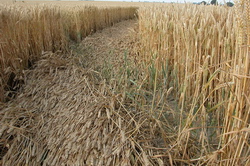
All crop fields have these parallel double tracks left by the wheels of the tractor in spring at the time of sowing. Generally, the grain (wheat for example) has not been sown in the lines where the dirt is exposed. This conveniently provides a way for the visitors to walk through the fields without damaging the crops. But the wheat sown on the edges of the tractor tracks often has been crushed by the tractor and as a result the germination of the kernels is delayed. Indeed shorter green stems can be observed in the early summertime when the crops are high and golden ripe.
These slower growing stems haven't been flattened to the ground and stand up skywards unlike those surrounding them inside of the formation (photos  7,
7,  8,
8,  9,
9,  10 and
10 and  11). This is how we have rows of vertical ears on the edges of the tractor tracks inside the area where all stems have been flattened. This could be interpreted as an imperfection in the design.
11). This is how we have rows of vertical ears on the edges of the tractor tracks inside the area where all stems have been flattened. This could be interpreted as an imperfection in the design.
In fact, this phenomenon which looks strange at first sight can be easily accounted for.
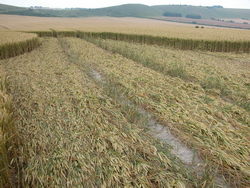
Indeed, farmers have noticed that this phenomenon appears as well when the wheat has been bent by a strong gust of wind, something which actually happens often. But in this case there will be no geometrical design formed. And yet in the event where the cause is natural, slower growing ears have been seen still erect and intact. This means that they better resist the wind force (they are more flexible because they are younger and still green).
Likewise, inside of crop circles, these slower growing ears could resist the force that bent all other stems because the force in question was controlled and limited to a minimum strength to bend the wheat whose growth is normal and did not affect the late stems which are more flexible and resistant.
However these wheat stems on the edges of the tractor tracks can also be flattened to the ground, not by an external force but by abutting stems that were themselves bent and leaning on them (photo  12). The direction in which the stems are bent is therefore a key sign.
12). The direction in which the stems are bent is therefore a key sign.
This observation is a reliable indicator of whether or not the crop circle is genuine. Indeed the use of a board or a roller to fold the stems would necessarily crush them all without exception.
Intact stems scattered in the bent stem areas
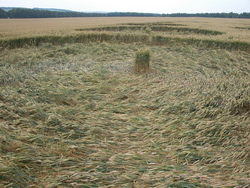
Inside of certain crop circles and regardless of the previous observation made about the intact rows along tractor tracks, not all wheat/barley stems are flattened to the ground: a portion has remained intact and pretty much vertical. This may give the impression that “the work has not been done properly”. Don't believe that this incomplete or amateurish aspect is associated with any kind of human achievement. The use of a mechanical tool (a board or a roller) would not leave a certain proportion of ears upright. This observation is proof that the crop has not been subjected to any mechanical force (human action). This just shows that the intensity of the force was a bit too weak to fold all of the stems so that a small proportion of them – the most resistant ones – remained upright (photos  13 and
13 and  14).
14).
Dead insects stuck to the stems
Insects such as flies (or others) are sometimes found stuck on stems, bodies parched and wings spread out. Parched hedgehogs are also found in crop circles. This observation supports the interpretation whereby these bugs/animals were caught by surprise by a sudden and very high temperature rise supposedly brief enough to not damage the crops.
Indeed, one might think the stems have been folded at the base once softened (and not broken) and this softening was caused by a very brief targeted temperature rise (tests performed in a lab by the BLT team directed by W. Levengood seem to confirm this interpretation). This then leads to appreciate why the temperature rise had to be set to a minimum not to damage the crops and this resulted in a small proportion of stems (more resistant) not being so affected (not so softened and hence not as folded). The parched flies and hedgehog observation is not compatible with a mechanical human work, which makes it additional evidence of the genuine nature of crop circles.
Energy of the area
Crop circles emit subtle energy which can be physically felt by anyone on the spot. Some people are however more sensitive to it than others. All they have to do is concentrate and become aware of the subtle sensations rising in their palms, feet and head. In all logics the more recent the formation the stronger the energy which weakens over time. Likewise the closer to the center of the formation the stronger the energy which weakens when moving away from it.
This energy can be observed with parallel divining rods and measured with a pendulum. The rods spectacularly amplify energy variations when getting into the formation or when moving away from it. The strength of this subtle energy is also a way to validate a genuine formation. Comparable energy variations can be observed on megalithic sites (photos  15 and
15 and  16).
16).
No marks on the ground

Most crop circles spread over several dozens of meters and up to hundreds of meters and therefore cover several tractor tracks in which it is possible to walk without leaving any marks. Sometimes small patterns are found all located between the tracks. Had this work been done by humans, they would necessarily have left marks such as wheat crushed for access. And yet the first visits onto a genuine site do not reveal any of that (photos  17 and
17 and  18).
18).
A variety of designs
Now that the designs are no longer straightforwardly circular (they were until the late eighties), a large variety of motifs can be observed especially as they all are different and their complexity is increasing from year to year. Several thousand crop circles have been observed so far.
This complexity is a response to incredulous observers: These “field sculptures” can't be achieved by humans going unnoticed.
Sometimes certain designs in fields are performed for promotional purposes and may be quite elaborate. But their achievement requires using a whole team working on it out in the open and for several days. Plus the technique used to flatten the wheat can only be basic because among other things, humans cannot bend the stems and nor can they create all the characteristics observed.
... achieved in a few seconds and no-one has ever been caught trying to create them!
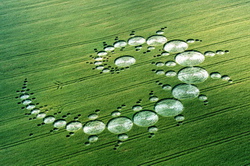
Even if the mystery behind the crop circle phenomenon is mainly due to the fact that these works are mostly achieved unnoticed, it just so happens however that the number of observations statistically significant to evaluate the time it takes to create a formation, has increased. And better yet, a number – not inconsequential – of people have had the opportunity to directly see a crop circle being created and could then testify to it.
One of the first significant testimonies is that of two airplane pilots interested in crop circles who – one day in 1996 – flew over Stonehenge twice the same day. They did not notice anything special the first time but the second time – a half hour later – near the megalithic site was a superb crop circle created without any of the visitors present on the site noticing. It is obvious that it could not be human-made (photos  19 and
19 and  20).
20).
Several dozens of lucky witnesses saw the creation of a crop circle in progress and their testimonies all matched (you can refer to specialized books on the subject (2-7-8-9-10-11)) : it usually takes approximately 10 seconds and without anyone being around. It may happen that a “light ball” moving rapidly over the field is associated with the creation of the crop circle.
Folding techniques ever more complex

As represented patterns grow ever more complex year after year, the bending technique is more and more sophisticated although some formations do remain relatively simple.
- A chekerboard effect can be observed with patches where the stems are flattened in a given direction when others are in another direction (photos
 21 and
21 and  22).
22). - In a circular area where the stems have been flattened, the center has often been set off by a sheaf of vertical stems. This sheaf can be either basic or intertwined with external stems (photos
 23,
23,  24 and
24 and  25).
25).
- At other times, the center marker is a bunch of folded stems the ears of which have been folded down so as to form a cone (photo
 26).
26). - Little “pits” of wheat can also be found where the stems have been assembled and twisted together to form like a central bundle at a height half way up the surrounding stalks (photos
 27 and
27 and  28).
28).
- • A large inner circle in a formation may also be quite complex and consist of several arrangements in which stems are alternately flattened in both circular and radial orientations (photo
 29).
29).
- • Or else, in a large circle, the stems can be flattened and oriented like rays from the center and thus creating a regular wavy effect (photo
 30).
30).
Again it is clear that these sophisticated folding techniques so well implemented cannot be attributed to man.
Off-center circles
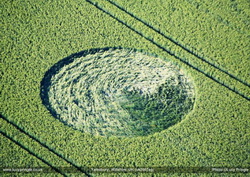
In the last few years, we have often seen circles either isolated or as part of complex drawings that are clearly “off-center” – meaning that the cereal stems are flattened around a point clearly distinct from the geometric center (photo  17). These observations are most meaningful because the only technique used by hoaxers to make a circle is to plant a stake in the geometric center and stamp around it with a board linked to the stake. As a result the stems are inevitably crushed all around the geometric center.
17). These observations are most meaningful because the only technique used by hoaxers to make a circle is to plant a stake in the geometric center and stamp around it with a board linked to the stake. As a result the stems are inevitably crushed all around the geometric center.
All previous observations show that a very large part of crop circles are created for reasons or by authors that are not human. Then the question is who or what makes them?
As a matter of fact unlike what was written in the nineties, it appears that almost all of the crop circles observed nowadays are genuine. Even if a small percentage of them have been created by hoaxers or for promotional purposes, the only ones worthy of interest are not those that are made by man but those that try to communicate with man.
Previous page...
Continue reading...
BIBLIOGRAPHIC REFERENCES (for this page):
2 : Colin ANDREWS et Stephen SPIGNESI - Crop Circles, signes et contacts : nouvelles révélations (Ed. Exclusif), p 65.
3 : W.C. LEVENGOOD - Anatomical anomalies in crop formations plants - Physiologia Plantarum, vol. 92 (pp 356-363), 1994.
4 : W.C. LEVENGOOD, J. BURKE - Semi-molten meteoric iron associated with a crop formation - Journal of Scientific Exploration, vol. 9, n° 2 (pp 191-199), 1995.
5 : W.C. LEVENGOOD, N. P. TALBOTT - Dispersion of energies in worlwide crop formations - Physiologia Plantarum, vol. 105 (pp 615-624), 1999.
6 : Eltjo HASELHOFF - Les cercles dans les blés et leurs mystères : recherches scientifiques et légendes (Ed. Favre).
7 : Michael HESEMANN - Messages, l'énigme des « crops-circles » (Ed. Trajectoire).
8 : Werner ANDERHUB et Hans Peter ROTH - Le Mystère des Crop Circles (Ed. Véga).
9 : Andreas MULLER - Crop Circles - Géométrie des cercles de culture, étude des phénomènes, recherches (Ed. Véga).
10 : Umberto MOLINARO - Des Cercles dans la nuit - Une enquête inédite sur le phénomène des Crop Circles (Ed. Equilibre).
11 : Lucy PRINGLE - Crop Circles - The Pitkin Guide (en anglais).
© 2010-2024 - Écoute la Terre (France)
